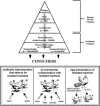Dissemination of fluoroquinolone-resistant Campylobacter spp. within an integrated commercial poultry production system
- PMID: 16672489
- PMCID: PMC1472311
- DOI: 10.1128/AEM.72.5.3441-3447.2006
Dissemination of fluoroquinolone-resistant Campylobacter spp. within an integrated commercial poultry production system
Abstract
While characterizing the intestinal bacterial community of broiler chickens, we detected epsilon-proteobacterial DNA in the ilea of 3-day-old commercial broiler chicks (J. Lu, U. Idris, B. Harmon, C. Hofacre, J. J. Maurer, and M. D. Lee, Appl. Environ. Microbiol. 69:6816-6824, 2003). The sequences exhibited high levels of similarity to Campylobacter jejuni and Campylobacter coli sequences, suggesting that chickens can carry Campylobacter at a very young age. Campylobacter sp. was detected by PCR in all samples collected from the ilea of chicks that were 3 to 49 days old; however, it was detected only in the cecal contents of chickens that were at least 21 days old. In order to determine whether the presence of Campylobacter DNA in young chicks was due to ingestion of the bacteria in food or water, we obtained commercial broiler hatching eggs, which were incubated in a research facility until the chicks hatched. DNA sequencing of the amplicons resulting from Campylobacter-specific 16S PCR performed with the ileal, cecal, and yolk contents of the day-of-hatching chicks revealed that Campylobacter DNA was present before the chicks consumed food or water. The 16S rRNA sequences exhibited 99% similarity to C. jejuni and C. coli sequences and 95 to 98% similarity to sequences of other thermophilic Campylobacter species, such as C. lari and C. upsaliensis. The presence of C. coli DNA was detected by specific PCR in the samples from chicks obtained from a commercial hatchery; however, no Campylobacter was detected by culturing. In order to determine whether the same strains of bacteria were present in multiple levels of the integrator, we cultured Campylobacter sp. from a flock of broiler breeders and their 6-week-old progeny that resided on a commercial broiler farm. The broiler breeders had been given fluoroquinolone antibiotics, and we sought to determine whether the same fluoroquinolone-resistant strain was present in their progeny. The isolates were typed by pulsed-field gel electrophoresis, which confirmed that the parental and progeny flocks contained the same strain of fluoroquinolone-resistant C. coli. These data indicate that resistant C. coli can be present in multiple levels of an integrated poultry system and demonstrated that molecular techniques or more sensitive culture methods may be necessary to detect early colonization by Campylobacter in broiler chicks.
Figures




References
-
- Allen, K. J., and M. W. Griffiths. 2001. Use of luminescent Campylobacter jejuni ATCC 33291 to assess eggshell colonization and penetration in fresh and retail eggs. J. Food Prot. 64:2058-2062. - PubMed
-
- Barrett, T. J., H. Loir, J. H. Green, R. Khakhria, J. G. Wells, B. P. Bell, K. D. Greene, J. Lewis, and P. M. Griffin. 1994. Laboratory investigation of a multistate food-borne outbreak of Escherichia coli O157:H7 by using pulsed-field gel electrophoresis and phage typing. J. Clin. Microbiol. 32:3013-3017. - PMC - PubMed
-
- Buhr, R. J., N. A. Cox, N. J. Stern, M. T. Musgrove, J. L. Wilson, and K. L. Hiett. 2002. Recovery of Campylobacter from segments of the reproductive tract of broiler breeder hens. Avian Dis. 46:919-924. - PubMed
-
- Camarda, A., D. G. Newel, R. Nasti, and G. Diamond. 2000. Genotypying Campylobacter jejuni strains isolated from the gut and oviduct of laying hens. Avian Dis. 44:907-912. - PubMed
-
- Chuma, T., T. Yamada, K. Yano, K. Okamoto, and H. Yugi. 1994. A survey of Campylobacter jejuni in broilers from assignment to slaughter using DNA-DNA hybridization. J. Vet. Med. Sci. 56:697-700. - PubMed
Publication types
MeSH terms
Substances
Associated data
- Actions
- Actions
- Actions
- Actions
- Actions
LinkOut - more resources
Full Text Sources
Medical
Molecular Biology Databases
Miscellaneous

